
Boraginaceae, the borage or forget-me-notfamily, includes about 2,000 species of shrubs, trees, and herbs in 146 to 154 genera with a worldwide distribution.

Echinacea is a genus of herbaceous flowering plants in the daisy family. It has ten species, which are commonly called coneflowers. They are native only in eastern and central North America, where they grow in wet to dry prairies and open wooded areas. They have large, showy heads of composite flowers, blooming in summer. The generic name is derived from the Greek word ἐχῖνος, meaning "hedgehog", due to the spiny central disk. These flowering plants and their parts have different uses. Some species are cultivated in gardens for their showy flowers. Two of the species, E. tennesseensis and E. laevigata, were formerly listed in the United States as endangered species; E. tennesseensis has been delisted due to recovery and E. laevigata is now listed as threatened.
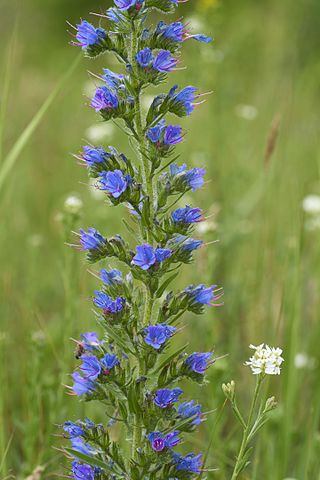
Echium vulgare, known as viper's bugloss and blueweed, is a species of flowering plant in the borage family Boraginaceae. It is native to most of Europe and western and central Asia and it occurs as an introduced species in north-eastern North America, south-western South America and the South and North Island of New Zealand. The plant root was used in ancient times as a treatment for snake or viper bites. If eaten, the plant is toxic to horses and cattle through the accumulation of pyrrolizidine alkaloids in the liver.

Echium is a genus of flowering plants in the family Boraginaceae that contains about 70 species and several subspecies.
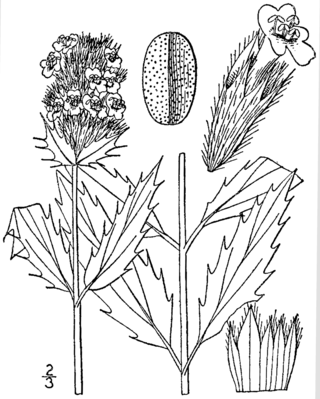
Dracocephalum parviflorum, known as dragonhead mint or American dragonhead, is a wild North American mint growing across much of the United States, as well as much of Canada and Alaska. It grows as either an annual or biennial, producing clusters of small pink to violet flowers in whorls at the ends of many branching stems. The seeds are small, dark, and high in oil content, about 20%.
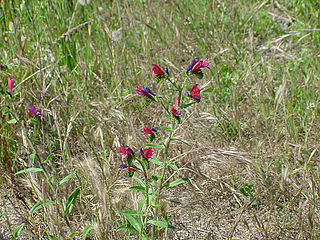
Echium creticum, the Cretan viper's bugloss, is a species of flowering plant in the family Boraginaceae. It is native to the western Mediterranean Basin. It is also used as an ornamental plant.

Echinacea purpurea, the eastern purple coneflower, purple coneflower, hedgehog coneflower, or echinacea, is a North American species of flowering plant in the family Asteraceae. It is native to parts of eastern North America and present to some extent in the wild in much of the eastern, southeastern and midwestern United States as well as in the Canadian Province of Ontario. It is most common in the Ozarks and in the Mississippi/Ohio Valley. Its habitats include dry open woods, prairies and barrens.
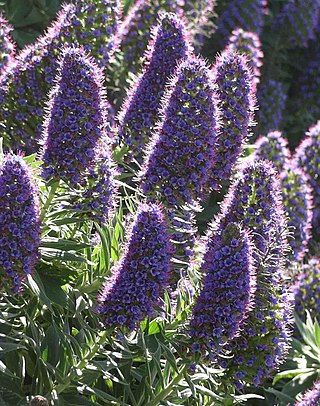
Echium candicans, the 'Pride of Madeira', is a species of flowering plant in the family Boraginaceae, and genus Echium, native to the island of Madeira. It is a large herbaceous perennial subshrub, growing to 1.5–2.5 m.
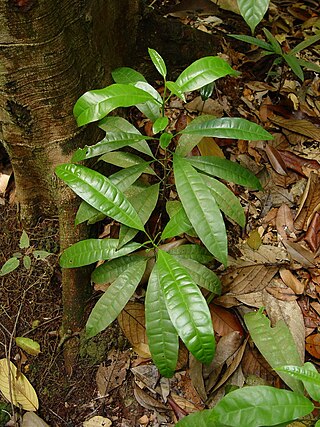
Maclurodendron is a plant genus in the family Rutaceae. It was first described in 1982 by Thomas Gordon Hartley. It consists of six evergreen tree species native to China and Southeast Asia.
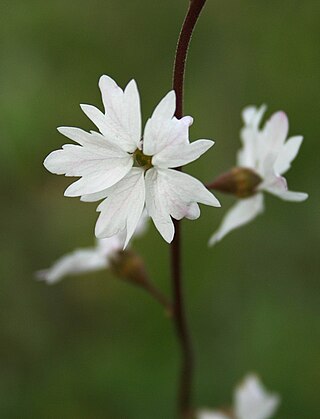
Lithophragma is a genus of flowering plants in the saxifrage family containing about nine species native to western North America. These plants are known generally as woodland stars. The petals of the flowers are usually bright white with deep, long lobes or teeth. Each petal may look like three to five petals, when at closer inspection the lobes fuse into a single petal at its base. Most species reproduce via bulblets instead of seeds. L. maximum is a federally listed endangered species. Lithophragma specifically coevolved with moths of the genus Greya, who pollinate and only lay eggs on Lithophragma plants.
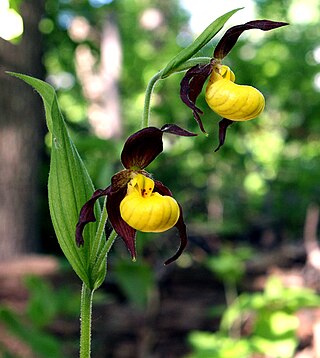
Cypripedium parviflorum, commonly known as yellow lady's slipper or moccasin flower, is a lady's slipper orchid native to North America. It is widespread, ranging from Alaska south to Arizona and Georgia. It grows in fens, wetlands, shorelines, and damp woodlands.

Echium pininana, commonly known as the tree echium, pine echium, giant viper's-bugloss, or tower of jewels, is a species of flowering plant in the borage family Boraginaceae. It is endemic to the Canary Islands, where it is restricted to the island of La Palma. Echium pininana is an endangered species, and is listed in Appendix I to, and is therefore protected under, the Convention on the Conservation of European Wildlife and Natural Habitats. The specific epithet pininana is Latin for "small pine", though E. pininana is neither closely related to the pine, nor does it resemble that plant.
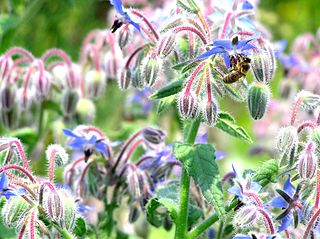
Boraginoideae is a subfamily of the plant family Boraginaceae s.s, with about 42 genera. That family is defined in a much broader sense in the Angiosperm Phylogeny Group (APG) system of classification for flowering plants. The APG has not specified any subfamilial structure within Boraginaceae s.l.

Trillium albidum is a species of flowering plant in the bunchflower family Melanthiaceae. It is the only trillium characterized by a stalkless white flower. The species is endemic to the western United States, ranging from central California through Oregon to southwestern Washington. In the San Francisco Bay Area, it is often confused with a white-flowered form of Trillium chloropetalum. In northern Oregon and southwestern Washington, it has a smaller, less conspicuous flower.

Saxifraga rosacea, Irish saxifrage, or rosy saxifrage, is a herbaceous plant in the family Saxifragaceae. The epithet rosacea does not refer to its flowers which are white, but to its radical sterile shoots which are often rosy. Owing to this misleading epithet, the rosy-flowered Saxifraga × arendsii is sometimes misidentified as Saxifraga rosacea.

Echium rauwolfii is a species of flowering plant in the family Boraginaceae, whose native range is North Africa to the Arabian Peninsula.
Perryodendron is a monotypic genus of flowering plants belonging to the family Rutaceae. The only known species is Perryodendron parviflorum.

Anodendron parviflorum is a species of flowering plant in the family Apocynaceae, native to tropical Asia. It was first described by William Roxburgh in 1832 as Echites parviflorus.

Echium horridum is a species of flowering plant native to North Africa, including the Sahara desert and the Sahel region.

Echium perezii, also known as Echium wildpretii subsp. trichosiphon, is a biennial herbaceous plant in the family Boraginaceae. which is native to the Canary Islands.



















